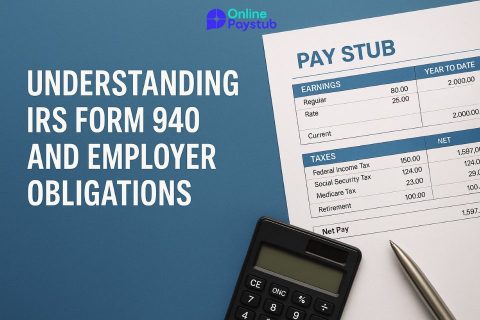Federal Income Tax (FIT) is a mandatory deduction withheld from your paycheck by your employer and remitted to the Internal Revenue Service (IRS) on your behalf. This tax applies to most forms of earned income and is the primary funding source for federal programs such as national defense, infrastructure, healthcare, education, and debt servicing.
The FIT tax isn’t an optional withholding; it is a legal obligation governed by federal tax law. If you are classified as an employee under U.S. tax code and earn above a certain threshold, a portion of your wages is subject to this federal tax. The exact amount deducted depends on several factors including your filing status, taxable income, and the information you provide on your IRS Form W-4.
The reason this tax appears consistently on your paycheck is because the U.S. operates under a “pay-as-you-earn” tax system. This means that taxes are collected throughout the year instead of waiting until you file your return. The IRS uses this system to ensure a consistent flow of revenue while reducing the risk of large end-of-year tax debts for most individuals.
It’s important to note that while FIT is one of several deductions you might see on your pay stub, it is distinct from other withholdings like Social Security (part of FICA), Medicare, or state income tax. Each serves a different purpose and is calculated using separate criteria.
How Is FIT Tax Calculated Based on IRS Guidelines?
FIT tax calculation is determined by IRS-issued tables and methods that account for both the employee’s financial profile and the pay cycle structure. Employers are legally responsible for withholding the correct amount from each paycheck, and this amount is based on the information reported on IRS Form W-4.
Core Calculation Factors:
- Filing Status
Whether you’re single, married filing jointly, or head of household directly impacts your marginal tax rate and applicable standard deduction. - Pay Frequency
IRS withholding tables differ based on how often an employee is paid—weekly, biweekly, semimonthly, or monthly. The calculation is scaled accordingly. - Taxable Wages
FIT taxable income includes regular wages, bonuses, commissions, and other earnings minus pre-tax deductions (e.g., contributions to health insurance or retirement plans like a 401(k)). - Withholding Allowances and Adjustments
The W-4 form allows employees to request adjustments to withhold more or less tax. Additional income, itemized deductions, and credits can all affect the outcome. - IRS Withholding Methods
Employers may use either the Percentage Method or the Wage Bracket Method. The choice depends on payroll systems and the complexity of employee inputs on the W-4.
Example Scenario (Wage Bracket Method):
For a single employee earning $1,200 biweekly in 2024, with no additional deductions or credits, the employer may be required to withhold approximately $74 in FIT tax per paycheck. This is calculated using the IRS wage bracket tables, which factor in standard deduction and marginal tax brackets.
What Income Is Subject to FIT Tax Withholding?
The Internal Revenue Code defines which types of compensation are subject to federal income tax withholding. FIT tax applies primarily to earned income, but several other categories of payments also fall within its scope. Understanding the distinction between taxable and non-taxable income is essential for both employees and employers to ensure accurate withholding and compliance.
Income Types Typically Subject to FIT Withholding:
- Wages and Salaries
This includes hourly pay, annual salaries, overtime, and shift differentials. All compensation in exchange for services performed is fully taxable unless otherwise excluded. - Bonuses and Commissions
Supplemental income such as performance bonuses or sales commissions is FIT-taxable. Employers often use a flat withholding rate (e.g., 22%) for these payments unless aggregated with regular wages. - Tips and Gratuities
Tips reported to employers by employees are considered taxable wages. The IRS requires employers to withhold FIT based on the reported amounts. - Prizes, Awards, and Incentives
Non-cash and cash incentives offered by employers such as travel awards or gift cards—are treated as taxable compensation. - Unemployment Compensation and Severance Pay
Both are treated as income and generally subject to withholding, although often taxed differently from standard wages. - Business and Self-Employment Income
For contractors or freelancers classified as self-employed, income is not subject to automatic FIT withholding, but they are still required to pay estimated taxes quarterly. - Taxable Fringe Benefits
Certain employer-provided benefits like personal use of a company car or non-qualified moving expenses—are FIT taxable.
Income Not Typically Subject to FIT Withholding:
- Employer contributions to qualified retirement plans
- Health insurance premiums paid by the employer
- Qualified tuition assistance
- Certain welfare benefits and workers’ compensation
- Employer-paid group term life insurance under specific thresholds
How Does Your W-4 Filing Affect FIT Tax Liability?
The IRS Form W-4 is the primary tool employees use to communicate how much federal income tax should be withheld from their paychecks. While the form itself does not calculate the FIT tax, it provides the necessary inputs for employers to apply IRS withholding formulas accurately. A misunderstanding or misrepresentation on this form can lead to over or under withholding both of which carry financial consequences.
Key Elements on the W-4 That Influence FIT Withholding:
- Filing Status
This is one of the most influential variables. Choosing between “Single,” “Married filing jointly,” or “Head of household” changes your standard deduction and tax bracket assumptions, directly affecting the withheld amount. - Multiple Jobs or Spouse’s Income
If an employee holds more than one job or if their spouse also works this section helps prevent under-withholding. The form offers guidance for adjusting based on combined household income. - Dependents
Claiming dependents reduces your tax liability by increasing your eligibility for credits like the Child Tax Credit. This lowers the FIT withholding amount. - Other Income
Additional income not subject to withholding such as dividends, interest, or freelance earnings—can be disclosed here to trigger higher withholding and offset future tax liability. - Deductions
Taxpayers who plan to itemize deductions beyond the standard deduction can account for these, thereby reducing FIT withholding further. - Extra Withholding
The form allows an optional dollar amount to be withheld from each paycheck. This is commonly used to cover underpayments or plan for irregular income.




No comments to show.